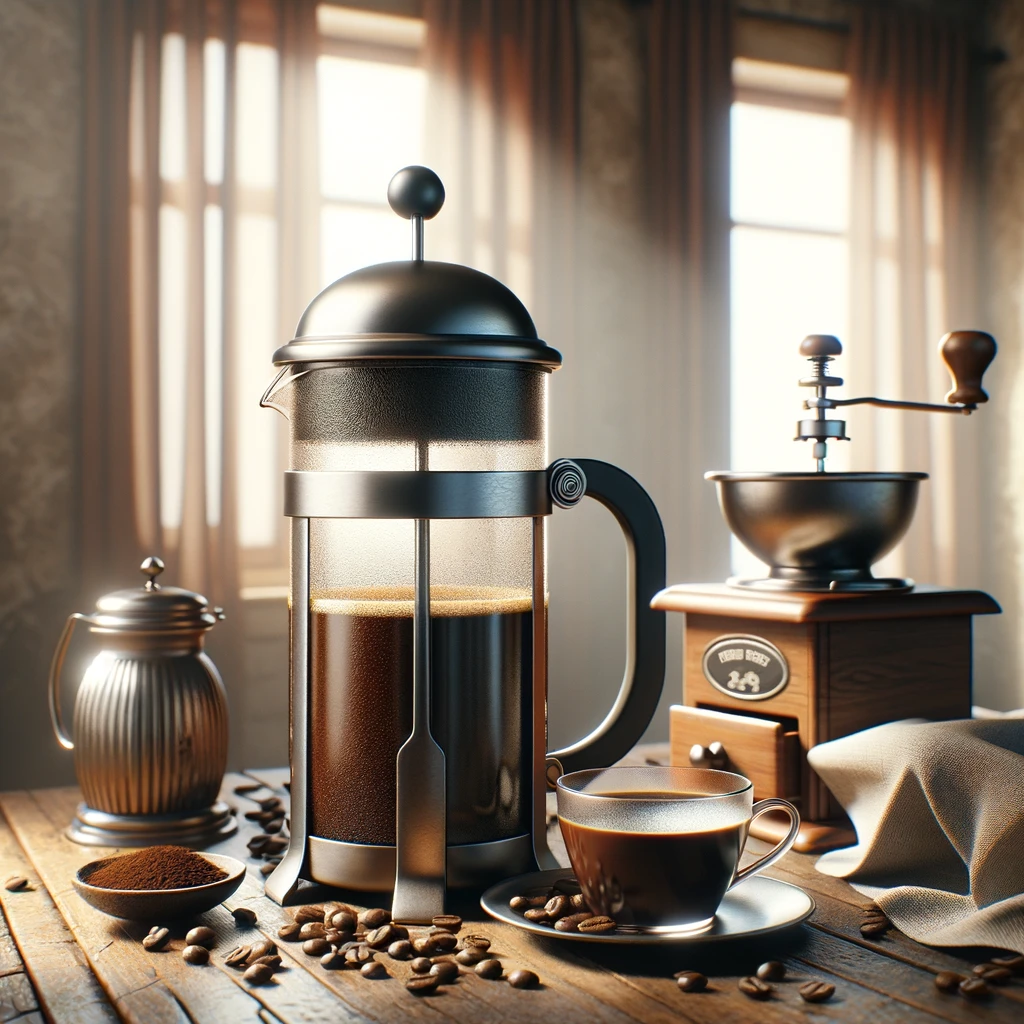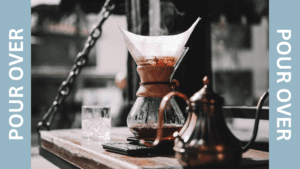
In the ever-evolving world of coffee aficionados, French press brewing has become an essential skill for crafting the perfect cup. High-quality French press coffee is the result of a careful process, and understanding the key elements is crucial for achieving a rich and flavorful brew. In this comprehensive guide, we’ll unveil the secrets of French press coffee brewing and provide actionable tips to elevate your coffee experience.
Disclaimer: Some of the links within this post are affiliate links which means if you click on our recommended products and decide that product is right for you, I may earn a commission on that purchase at no cost to you. As an Amazon Associate, I earn from qualifying purchases. All content and opinions remain my own.
Your French Press Ultimate Guide
Table of Contents
Choosing the Right Coffee Beans:
The selection of coffee beans is pivotal in shaping the taste of your French Press coffee. While personal preference plays a significant role, there are general guidelines to help you choose the best beans for this brewing method.
- Roast Profile: French Press coffee typically shines with medium to dark roast beans, which provide a richer, fuller body and deeper flavors that the French Press method extracts so well.
- Origin: Single-origin beans can offer unique and distinct flavors, while blends often provide a balanced profile. Experiment with beans from different regions to find your favorite taste notes.
- Freshness: Always opt for freshly roasted beans to ensure maximum flavor. Beans should be used within a month of their roast date for optimal taste.
- Ethical Considerations: Choose fair trade and ethically sourced coffee when possible. These options not only support sustainable farming practices but also ensure that coffee producers are compensated fairly. This adds an ethical dimension to your coffee experience, contributing to a more responsible and conscious coffee culture.
Determining the Perfect Water-to-Coffee Ratio:
The water-to-coffee ratio is crucial in achieving the ideal strength and flavor balance in your brew.
- Standard Ratio: A good starting point is a 1:15 coffee-to-water ratio. This means using 1 gram of coffee for every 15 milliliters of water. For example, for 30 grams of coffee, use 450 milliliters of water. This ratio provides a balanced brew that can be adjusted based on personal taste.
- Adjusting to Taste: If you prefer a stronger brew, decrease the water ratio, and for a lighter brew, increase it. Experimentation is key to finding your perfect balance.
- Volume vs Weight: When measuring your coffee brews, always use weight over volume. Many factors can influence the volume of your coffee so to ensure consistency always measure your coffee and water by weight.
Optimizing Grind Size for French Press:
Grind size is another essential factor in French Press brewing, as it affects the extraction and final flavor of your coffee.
- Coarse Grind: Aim for a coarse, even grind similar to sea salt. This size allows for optimal extraction while preventing fine grounds from slipping through the press filter and into your cup.
- Consistency: Ensure that your grind is consistent. Uneven grinds can lead to both over-extraction (bitterness) and under-extraction (sourness).
There are plenty of options when it comes to grinders, we will have a separate blog dedicated to just grinders in the future. To get you started, investing in a good grinder will save you in the long run. We recommend the Baratza grinder range. They are highly regarded in the coffee community for their precision and durability. They offer a range of models suitable for various brewing methods, from espresso to French Press. Key benefits include their consistent grind size, robust build quality, and user-friendly interfaces. Many models feature adjustable grind settings, allowing for fine-tuning to match specific brewing requirements. Baratza’s commitment to quality and customer service also adds to its appeal among coffee enthusiasts.
Recommended French Presses:
While the quality of coffee beans is vital, the choice of a French Press is equally important. For those looking to enhance their brewing technique, we highly recommend the Bodum, Espro, and Stanley range of French Press brewers. Each offers unique features to optimize your brewing experience. Look for filter size to minimize the amount of sediment that will potentially enter your cup, heat retention, and material quality.
Crafting a Compelling Coffee Bloom:
The coffee bloom is a crucial step in the French press brewing process. This initial phase sets the stage for the entire brewing process and is essential for developing a full and balanced flavor.
- What is Coffee Bloom?: The bloom is the process of releasing carbon dioxide from freshly ground coffee. When hot water first contacts the grounds, it releases gas in a bubbling effect. This release is crucial for flavor development as it allows the water to more effectively saturate and extract flavor from the coffee grounds.
- Brewing Technique:
- Add Your Coffee: Place your freshly ground and weighed coffee into your French Press.
- Add Hot Water: Start by gently pouring water just off the boil (around 200°F or 93°C) over the coffee grounds. Aim to ensure all of your grounds are fully saturated by the time you have reached your desired water weight as per your preferred ratio.
- Breaking The Crust: After your brewing time is up, with the back of the spoon, break away the top crust allowing the grounds to agitate and fall to the bottom of the liquid. You will find a small amount of grounds, bubbles, and crust remains at the top. Remove these with your spoon and discard them.
- Patience Time: This is the hard part… wait for another 5 minutes to allow all of the smaller coffee sediment to fall to the bottom of the French Press BEFORE using your plunger lid. Waiting this second time allows the smaller particles to fall and settle at the base. Using the plunger to push these down will create pressure in your liquid forcing the small particles up and through your mesh filter leaving a grainy final cup.
- Time To Plunge (Sort Of…): Some manufacturers advise a full plunge, while others recommend only plunging to the top of the liquid. Our recommendation to get the cleanest cup is to plunge to just below the water surface, repeatedly getting lower after each pour. From our testing, this creates the cleanest cup possible without agitating the fine sediment. The plunger mesh still acts as a filter for escaping grounds so don’t be worried about a ‘chunky’ coffee. If you do prefer to use your plunger all the way, do it slowly. The faster you push, the more pressure in the liquid, and the more agitation will be created mixing up the fine sediment leading to a cloudy and gritty cup. Whatever your choice, experiment to find what you prefer.
- Brew Time Guidance:
- Total Brew Time: The total brew time for French Press should generally be around 4 minutes. This includes the bloom time and water addition. Then additional resting of around 5 minutes post brew. This step is certainly not mandatory and depends on your preference. It will also depend on your grind size, and coffee bean roast level but a good all-around brew number is 4 minutes.
- Adjusting Brew Time: Depending on your taste preference, you can adjust this time. A shorter brew will result in a lighter cup, while a longer brew will enhance the body and strength of the coffee. Experiment to find your ideal balance.
Creating a Flavorful and Balanced Brew:
The heart of your French press journey lies in achieving a flavorful and balanced brew. Focus on the water temperature and steeping time – the optimal temperature is around 200°F or 93°C just below boiling, and the steeping time varies based on personal preference. Experiment with different steeping times to find the perfect balance that suits your taste. As your brewed coffee cools down closer towards body temperature you will pick up more of the coffee’s natural flavour. Your taste buds will recognize flavor notes easier as your brew cools down so keep your notes going throughout your tasting experience.
Designing for Coffee Extraction:
A well-designed French press brewing process should extract the full range of flavors from your coffee grounds. Ensure a consistent grind size, as this contributes to even extraction. Experiment with the coffee-to-water ratio to fine-tune the strength of your brew. The design of your French press, including the materials and build, can also impact the brewing process and the final taste.
Optimization for Brewing Consistency:
Consistency is key to mastering French press coffee brewing. Pay attention to details such as the grind size, water temperature, and steeping time to reproduce your desired flavor consistently. Keep a brewing journal to document your preferences and any adjustments made during the brewing process. There are plenty available to purchase, but a simple sheet of paper and a pen or spreadsheet will do the job perfectly fine.
Measuring coffee by weight rather than volume is preferred for several reasons, especially when aiming for consistency and precision in brewing:
- Consistency: Coffee beans and grounds can vary significantly in size and density, which means a scoop of one type of coffee might not have the same amount of coffee by weight as the same scoop of another type. Measuring by weight ensures that you’re using the same amount of coffee every time, regardless of its grind size or density.
- Accuracy in Brewing Ratios: Specialty coffee brewing often relies on specific ratios of coffee to water (like 1:16 or 1:18 grams of coffee to water) to achieve the desired strength and flavor profile. Measuring by weight allows for precise adherence to these ratios.
- Control over Extraction: The extraction process, which is how flavors and compounds are pulled from the coffee grounds into the water, is highly sensitive to the coffee-to-water ratio. Small changes in the amount of coffee can significantly affect the taste. Weighing the coffee allows for better control over this extraction, leading to a more consistent and desirable flavor.
- Compaction Variability: The way coffee is ground and stored can affect its volume. For instance, freshly ground coffee can take up more volume than pre-ground coffee due to air trapped between particles. This variability is eliminated when measured by weight.
- Adaptability Across Brewing Methods: Different brewing methods (like drip, French press, espresso) often require different grind sizes, which can affect volume. Measuring by weight provides a consistent standard across these methods.
- Professional Standards: In professional settings like cafes and for coffee competitions, weight measurements are the standard because of all the above reasons. They ensure that every cup of coffee is as close to the desired quality as possible.
Test, Analyze, and Optimize Your Brew:
To achieve the perfect French press coffee, embrace a culture of continuous improvement. Experiment with different coffee beans, grind sizes, and brewing techniques. Analyze the nuances in flavor and adjust your approach accordingly. Regularly revisit and refine your brewing process to elevate your French press coffee game.
Let’s Sum It Up:
Mastering the art of French press coffee brewing requires a combination of knowledge, experimentation, and attention to detail. By understanding your coffee beans, crafting a compelling coffee bloom, and optimizing your brewing process for consistency, you can elevate your French press coffee experience. Embrace the journey of discovering the perfect balance of flavors, and with these tips and best practices, you’ll be well on your way to becoming a French press brewing maestro.

For more coffee brewing tips check out our other blog posts here, or contact us if you would like us to delve deep into a particular type of brewing method you are interested in.




